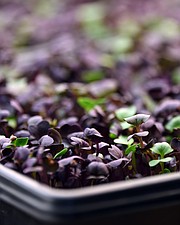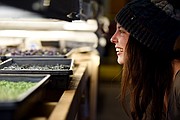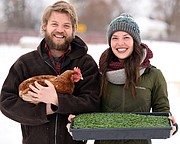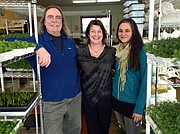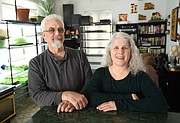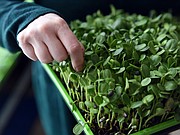Local microgreens farmers offer a harvest of nutrition in tiny packages
Local microgreens growers have come up with innovative ways to use their product.
EarthStar Farms owner Susan Waite of Whitefish mixes microgreens into her homemade macaroni and cheese and sticks them into a grilled cheese sandwich or a hamburger.
Ashley Kwasney of Gecko Mountain Farm in Somers throws them in soup, omelets and pasta dishes, and adds them to her oatmeal.
Her husband, Gary Kwasney, may have come up with one of the more novel uses for microgreens — he likes to put them on ice cream.
“The taste sells itself,” Brycen Ek of Heyday Homestead in the Lower Valley, said. Ek and his wife, Emma, also grow microgreens.
“From a culinary perspective, they enhance flavors. If you’re trying to create a spice or a lemon note, they’re awesome on anything.”
A handful of tiny microgreens is an intense concentration of vitamins, antioxidants fibers, minerals and amino acids. They have been popular with chefs for years, adding a touch of vibrant color or a complementary texture to any dish. Microgreens are vegetable seeds grown to their cotyledon state and harvested at the embryonic stage of growth. Though nutritional analysis varies, the miniscule microgreens are packed with vitamins and other desirable elements, with some studies showing the greens can offer 40 times the vitamins, C, E, and K, lutein and beta-carotene than the mature plants. Nutrition benefits vary within the microgreen varieties, of which there are dozens.
Chad and Susan Waite are entering their third year as microgreens growers. They gardened while raising a family in Seattle and wanted a new farming challenge after they moved to the Flathead Valley. They converted the attached garage of their home in the Whitefish area into a window-filled space for growing and a shop and washing area for harvesting and processing.
The couple took over a customer list from friends who had been providing microgreens to valley clients and doubled it in the first year. EarthStar Farms now sells to the Super 1 Foods chain, Markus Foods in Whitefish and Mountain Valley Foods in Kalispell, as well as a number of chefs.
A few employees assist with the weekly microgreens harvest and a manager, Lanon Lohof, also helps with EarthStar’s vegetable garden, chickens and sheep. (EarthStar also sells eggs and wool.)
Before investing in the process, the Waites investigated the microgreens market to ensure it wasn’t a fad. Their son, a chef in Seattle, assured them microgreens are here to stay.
“It’s a real trend, not just a foodie trend,” Susan Waite said. “What’s driving it is everyone’s awareness of a lack of deep nutrition in our food. Even if you buy an organic carrot, our soils are depleted of minerals.
Brycen and Emma Ek have been growing microgreens for a year. The couple met in Macedonia in the Peace Corps, and wanted to start an organic farm on their Lower Valley acreage.
With Heyday Homestead still in the construction stage, the Eks began by cultivating trays of microgreens under grow lights in the dark basement of the Camas Creek Cottage yarn store on Main Street in Kalispell.
Even while confined to a small space, the Eks produced enough greens for 30 weekly subscribers, and sold microgreens along with their vegetables at farmers markets last summer.
They are not growing microgreens this winter, as they are focused on moving to the farm where they are working to create their four-seasons operation.
However, they will begin providing greens for subscribers on April 6.
“Working directly with customers is so rewarding,” Emma said. “To see how microgreens affect them on energy and health levels and to be able to connect specifically with the people.”
The Eks recently finished 10th in an online vote among about 150 farms nationwide seeking a Cultivating Change grant. Heyday Homestead was seeking infrastructure funding in the contest, and even though they needed to finish in the top five to secure any money, they were happy to gain the support and publicity the contest provided.
The Eks have become friends with the Kwasneys, whose Gecko Mountain Farm operation is found in a corner of their Somers-area living room. Racks of trays line two walls and Gary does all the planting on his kitchen countertop.
The Kwasneys don’t need room for processing because they sell the greens in their growing containers.
“What’s unique about us is we sell them live,” Ashley Kwasney said. “When you cut anything it loses its nutrients. My goal is to make sure people are getting all the extra nutrients. These sit out and you clip them when you’re ready to eat them.”
The Kwasneys started selling at local farmers markets last summer and have a few catering and restaurant accounts.
Ashley Kwasney believes that microgreens are somewhat of a miracle food.
“The health benefits are astounding,” she said. “We haven’t gotten sick since we’ve been eating them. Haven’t had any colds or flu. There’s all that extra vitamin C and antioxidants.”
Microgreens offer not only flexibility in growing circumstances, but the seeds can be cultivated in a variety of mediums.
The Kwasneys mostly use Sun Gro Professional Growing Mix, a soil-free substance of peat-moss and Perlite. They’ve experimented with bases such as hemp pads for a cleaner product, but the greens take longer to germinate. The Eks use an organic soil mix from Peaco Peat Moss in Big Arm. They tried out other methods such as hemp pads and cotton before deciding soil produces the best quality and quantity of microgreens.
Earth Star Farms has found success with a soil combination of three organic varieties. The Waites don’t reuse the soil for a second planting of microgreens, but use it in beds for their own vegetables and edible flowers and recycle it by selling it to local organic farmers or through donations to local schools.
Lighting is another point of divergence among microgreens growers. The Waites only use natural sources, even during the dark Flathead Valley winter, and find that their greens grow just fine. They have a wall of windows on one side, but the room isn’t technically a greenhouse. They keep careful track of the temperatures of their trays, covering them if they get too hot.
“Some people swear you have to put them under grow lights, but for us, ambient light has been fine.” Chad Waite said.
Brycen Ek has worked as an electrical contractor and he’s been able to nab lights from demolished buildings. The Kwasneys, who can fit 63 trays into their living-room shelves when they need the greens for market, use bright white LED bulbs.
The Kwasneys have an evangelical background, traveling to Honduras and Costa Rica on mission trips and living in Honduras for three years to started a bilingual Christian school.
They’re now spreading the word about microgreens. Glacier High School science teacher Sarah Conner last year invited them to grow microgreens with the students and they’ll be returning again this spring.
It’s an ideal lesson in botany, given that many varieties of greens require only a week from planting to harvest, Ashley Kwasney said.
“Everyone gets to eat microgreens within a week. We can get kids excited about growing their own food. We’re working on developing a kit for a classroom.”
The Kwasneys have created a home starter package for growing microgreens, which they sell on their website. Buyers can choose the varieties of greens they want and subscribe to receive regular seed deliveries.
There are many to try, as microgreens are as varied as vegetables, each offering a different texture and taste. Sunflower greens, for example, are rich and buttery. Pea greens are on the sweet side. Mustard greens have more of a bite, as do radish and arugula. Broccoli greens are also a popular mild variety.
EarthStar Farms labels its spicy blend of mustards, radishes, arugula, beets and amaranth its “Exhilarating Mix.”
The Waites are finicky about selling only perfect greens under the EarthStar name, with the chickens getting many of the leftovers.
“Our eggs are so nutritious because our chickens eat such a great diet year-round,” Susan Waite said. “It makes my heart happy to give people food that is so jam-packed with nutrition.”
For more information https://www facebook.com/EarthstarFarmWhitefish/
https://www.facebook.com/heydayhomestead/
https://geckomountainfarm.com/
Business reporter Heidi Gaiser may be reached at 758-4438 or hgaiser@dailyinterlake.com.
















